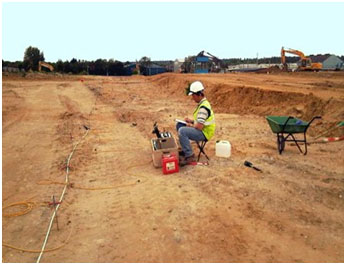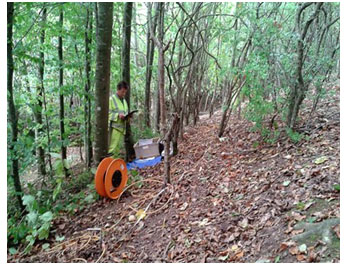- MEASURING INSTRUMENT MOD POLARES complete of internal energizer, integrated GPS module and internal rechargeable battery.
- CABLE WITH ELECTRODES
- LEAD-IN CABLE WITH CONNECTOR
- STAINLESS STEEL ELECTRODES
- SOFTWARE RES2DINV

Welcome to Drisana Geotechnical Consultancy!

Resistivity geophysical surveys measure variations in the electrical resistivity of the ground, by applying small electric currents across arrays of ground electrodes. The survey data has to be processed to produce graphic depth sections of the thickness and resistivity of subsurface electrical layers. The resistivity sections are correlated with ground interfaces such as soil and fill layers or soil-bedrock interfaces, to provide engineers with detailed information on subsurface ground conditions.
Resistivity geophysical surveys measure variations in the electrical resistivity of the ground, by applying small electric currents across arrays of ground electrodes. The survey data has to be processed to produce graphic depth sections of the thickness and resistivity of subsurface electrical layers. The resistivity sections are correlated with ground interfaces such as soil and fill layers or soil-bedrock interfaces, to provide engineers with detailed information on subsurface ground conditions.
ERT measures resistivity & Resistivity measured in Ω•m, is the mathematical inverse of conductivity. It is a bulk physical property of materials that describes how difficult it is to pass an electrical current through the material. Resistivity measurements can be made with either an alternating current (AC) or a direct current (DC). As resistivity measurements are frequency dependant, care must be taken when comparing resistivity values collected using different techniques.
Resistivity imaging, also known as electrical resistivity tomography (ERT) is a particularly useful survey method in clayey ground. The method can also help to identify transitional boundaries in subsurface layers that can be difficult to detect using other geophysical methods and is a useful tool for locating deep seated sinkholes and mine workings.
Traditional resistivity surveys use four equidistant electrodes in a standard configuration. A low frequency current shall be applied across the outer electrodes and the voltage measured across the inner electrodes. The voltage will be converted into a resistivity value representing average ground resistivity between the electrodes.
Depth probes provide models of vertical variations in ground resistivity using an expanding electrode array offset from a central reference point. Depth penetration increases with wider electrode separation, providing a one dimensional layered resistivity model. Composite sections are produced by interpolating between depth probes at regular intervals along a survey line. Resistivity imaging also known as resistivity tomography is an advanced development of the method. Enhanced data quality and resolution provide continuous two-dimensional resistivity models. Fifty or more electrodes are set-out in a regularly spaced array, connected to a computer-controlled resistivity meter via multicore cables.
are produced by interpolating between depth probes at regular intervals along a survey line. Resistivity imaging also known as resistivity tomography is an advanced development of the method. Enhanced data quality and resolution provide continuous two-dimensional resistivity models. Fifty or more electrodes are set-out in a regularly spaced array, connected to a computer-controlled resistivity meter via multicore cables.

Advanced data processing using specialist inversion software removes distortions caused by the effects of electrode geometry, to produce a high resolution image of the variations in ground resistivity with depth. The model is contoured using a color scale to produce a two-dimensional cross-sectional model of ground resistivity. Our geophysicists will use the final resistivity imaging section to provide clients with a detailed interpretation of the ground conditions on site.


